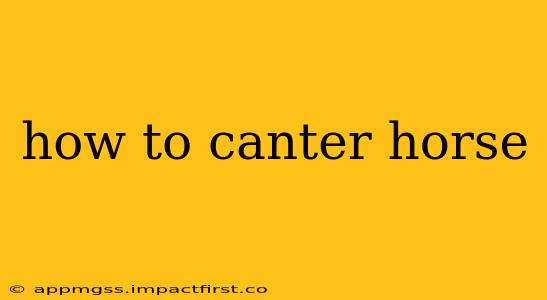Cantering is a thrilling and graceful three-beat gait, a crucial skill for any rider to master. Whether you're a beginner just starting your equestrian journey or an experienced rider looking to refine your technique, understanding the nuances of the canter is key to a harmonious and safe ride. This guide will walk you through the essential steps, addressing common questions and concerns along the way.
What are the Different Types of Canters?
There are two main types of canters: the right lead canter and the left lead canter. The lead refers to the leading leg – the front leg that leads the movement. Choosing the correct lead is crucial for balance and efficiency. Getting the lead wrong can make the horse uncomfortable and potentially lead to a fall.
How Do I Prepare My Horse for the Canter?
Before attempting a canter, ensure both you and your horse are prepared. This involves:
- Warm-up: A proper warm-up is essential to prepare your horse's muscles and loosen their joints. This typically includes walking and trotting in both directions, focusing on suppleness and responsiveness.
- Correct posture: Ensure your posture is upright and balanced, with your weight evenly distributed. Your seat should be secure and independent of your hands.
- Appropriate aids: Your aids (legs, seat, and reins) must be clear and consistent. The horse needs to understand your request before you transition to the canter.
How Do I Ask My Horse to Canter?
The specific aids used to ask for a canter depend on your horse's training and your instructor's preferences. However, common methods include:
- Using your seat: A slight shift in your weight and a gentle rise and fall in your seat can help initiate the transition. This works in conjunction with other aids.
- Using your legs: A slightly stronger application of your outside leg (the leg on the opposite side of the direction you wish to canter) combined with a slightly lighter inside leg, aids in the transition.
- Using your reins: Your reins provide support and balance, keeping the horse's head and neck in the correct position. Never pull excessively.
How Do I Maintain the Canter?
Maintaining a balanced and rhythmic canter involves a combination of:
- Correct posture and balance: Keep your weight centered and your body relaxed but alert. Avoid gripping with your knees or thighs.
- Consistent aids: Continue using subtle leg and seat aids to maintain the rhythm and impulsion of the canter.
- Proper rein contact: Keep a gentle but consistent contact with the reins to guide the horse and maintain balance.
How Do I Slow Down from a Canter?
Gradually slowing from a canter typically involves:
- Using your seat: First, slightly increase the weight in your seat. This will encourage the horse to shorten their stride.
- Using your legs: Then you will use your legs to maintain the energy and momentum, preventing your horse from stopping suddenly.
- Using your reins: Using your reins to carefully slow the gait, never pulling sharply, only supporting the slowing process. The transition from canter to trot will be the first step of slowing down, this then proceeds into a walk.
What if My Horse Canters on the Wrong Lead?
If your horse leads incorrectly, you can try to correct it with:
- Half halts: This will encourage the horse to rebalance.
- A light tap with the inside rein: Only a gentle tap, never pulling excessively.
- Adjusting your seat and leg aids: By refining your aids, you can influence the horse to change leads.
Important Note: Seeking guidance from a qualified riding instructor is crucial for both the horse and rider's safety. Learning to canter correctly requires patience, practice, and professional instruction.
What are Common Canter Mistakes to Avoid?
- Leaning too far forward: This unbalances the horse and can cause loss of control.
- Gripping too tightly with your legs and knees: This can make your horse tense and uncomfortable.
- Pulling on the reins: Pulling on the reins will interfere with the horse's balance and rhythm.
How Long Does It Take to Learn to Canter?
The time it takes to learn to canter varies widely depending on the rider's experience, the horse's training, and the quality of instruction. Some riders learn quickly, while others require more time and practice. Don't get discouraged – consistent practice and good instruction are key.
Remember, learning to canter is a gradual process that demands patience and consistent practice. Always prioritize safety and seek professional guidance from a qualified riding instructor. Enjoy the journey!
